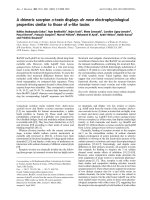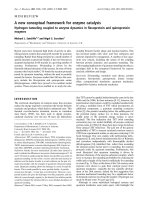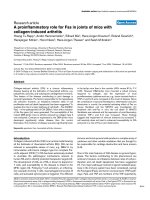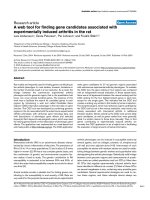Báo cáo y học: "A harsh climate" docx
Bạn đang xem bản rút gọn của tài liệu. Xem và tải ngay bản đầy đủ của tài liệu tại đây (273.1 KB, 3 trang )
Petsko: Genome Biology 2009, 10:115
I might as well come right out and say it: I don’t care
whether global warming is caused by manmade greenhouse
gas emissions. And neither should you.
Before you start reaching for your laptops, iPhones, and
BlackBerrys to fire off scathing emails, give me a moment
to explain why I made this statement and what it really
means. I bet that, when I’m through, you will agree with me.
This column is being written because of the confluence of
two events. One is a meeting in Copenhagen of repre-
sentatives of most of the world’s nations, aimed at formu-
lating a new global strategy for dealing with the climate
crisis. The talks have ground to a halt as I write this
because the group of developing countries, known as the
G-77, has accused the United States and other indus-
trialized states of forsaking the Kyoto Protocol, the current
climate agreement that imposes greenhouse gas emissions
on nearly every developed nation.
The second event is ‘Climategate’, the release of illegally
hacked emails between climatologists. As an example of
giving aid and comfort to the enemy, Climategate could
hardly be improved on. In late November, a computer file
including more than 1,000 emails either sent from or to
members of the University of East Anglia’s Climate
Research Unit (CRU) was stolen and released on the
Internet. The emails contain language that opponents of
emission curbs have seized on as alleged examples of data
manipulation and outright fraud on the part of climate
researchers. For example, one email apparently sent by the
head of the CRU, Professor Phil Jones, refers to using
“Mike’s Nature trick of adding in the real temps to each
series for the last 20 years … to hide the decline”. The CRU
is one of the leading research units on climate change, and
their data had a major role in the Fourth Assessment
Report of the Intergovernmental Panel on Climate Change
(IPCC), released in 2007, that provided unequivocal
evidence for global warming (see Figure 1).
Of course, scientists use the word ‘trick’ all the time as a
shorthand term for a method or algorithm, but professional
skeptics rarely bother themselves with the way scientists
work. It seems likely that the files were stolen in an attempt
to undermine the Copenhagen talks, but my assessment is
that there are so many other contentious issues in that
meeting that this is a relatively minor matter for most of its
participants. Nevertheless, Professor Jones has stepped
down as head of the CRU pending an internal investigation.
In my view, he should instead have been made to write on
the blackboard 1,000 times: “I will never put anything into
an email or text message that could be embarrassing to me
or to my organization if it were read by someone else, and
if I don’t believe this I should ask Tiger Woods.”
One of the most sensible things I have read about the
climate debate is an opinion piece by Stewart Brand in the
15 December 2009 edition of The New York Times. He
argues that the popular depiction of the combatants as
belonging to two camps, the alarmists and the skeptics, is
fallacious. There are actually four sides: denialists, a group
consisting of people with a right-wing political agenda who
assert that the claim that global warming is caused by
manmade emissions is a lie and is not based on sound
science; skeptics, a group largely comprising scientists who
argue that climate science, particularly large-scale
modeling, is far too imperfect to form the basis of a
consensus; warners, another group of scientists who
believe that the best climate models accurately predict a
looming planetary disaster and that human production of
greenhouse gases is the primary cause; and calamatists, a
collection of environmental activists whose agenda, like
that of the denialists, is ideologically driven, but in the
opposite direction: they have a neo-luddite view of
industrialization, and believe the denialists are evil. As
Brand, a self-described warner, points out, understanding
from which of these camps any given argument springs is
useful in distinguishing propaganda from science, and
appeals to emotion from evidence-based assertions.
Yet even Brand misses what I think is the crucial point, the
point I want to make in this column, which is that you can’t
win a war if you are fighting in the wrong field. And in the
war over climate change, which should be fought in the
field of science, the denialists and the calamatists have
dragged us into battle on their turf.
When you’re in a fight with an opponent who is not above
using invective and illogic, the worst mistake you can make
is letting the other side define the terms of the debate.
Comment
A harsh climate
Gregory A Petsko
Address: Rosenstiel Basic Medical Sciences Research Center, Brandeis University, Waltham, MA 02454-9110, USA.
Email:
115.2
Petsko: Genome Biology 2009, 10:115
That’s exactly what has happened in the argument about
climate change. For decades the denialists insisted that the
earth was not getting warmer. Short-term fluctuations
were meaningless, they asserted. Climate modeling was
worse than useless. The doomsayers were just trying to
push a liberal political agenda, and so on. But after massive
amounts of data were collected and analyzed by the
Intergovernmental Panel on Climate Change, it became
clear, on the release of their report in 2007, that no
sensible person could deny that a dramatic rise in the
planet’s average temperature had been occurring for at
least a century (see Figure 1). Largely thanks to Al Gore,
this information also reached the general public, whose
reaction even the staunchest denialists could not ignore.
So they did what clever, unprincipled losers often do: they
changed the issue. Of course the earth is getting warmer,
they said (blithely ignoring the fact that they had said
exactly the opposite the day before), but human activities
have nothing to do with it. It’s entirely due to natural
causes, and people who assert that manmade greenhouse
gases are causing the problem are employing flawed
science, deliberately distorting the facts (Climategate), and
are using fear to advance the same old, tired environmental
activism. Because global warming is not a manmade
phenomenon, there is no scientific or political reason to
limit manmade greenhouse gas emissions. Sarah Palin
(why am I not surprised?) is one of the leaders of this
chorus, stating recently that climate change occurs natu-
rally “like gravity”, while warning that reducing greenhouse
gas emissions will mean “job losses” and “economic costs”.
(This is the same ex-Alaska governor Sarah Palin who,
before becoming a national political figure, said in July of
last year, “Alaska’s climate is warming. While there have
been warming and cooling trends before, climatologists tell
us that the current rate of warming is unprecedented
within the time of human civilization. Many experts predict
that Alaska, along with our northern latitude neighbors,
will warm at a faster pace than any other areas, and the
warming will continue for decades.” I don’t know whether
to laugh at that kind of soulless opportunism or just cry.)
This strategy is actually working, to some extent. It’s much
harder to establish the cause of something than it is to
prove that something is happening, and the data support-
ing manmade emissions as the leading driver of climate
change are not nearly as persuasive, or as immune to
challenge, as the data demonstrating the fact of global
warming. And scientists, foolishly, have allowed that to
become the center of the climate crisis debate. I say
foolishly because, in so doing, they have given up the
victory that they already won.
The denialists have conceded the fact of climate change.
And here is my central point: once you admit that the earth
is warming rapidly, it does not matter in the least whether
that trend is due to manmade causes or not.
Regardless of its origin, a rapidly changing climate is a very
bad thing. We have built an entire civilization on the
assumption of long-term climate stability. We grow wheat
in Kansas rather than in the Yukon because Kansas has an
ideal climate for growing wheat and the Yukon is too cold,
and we assume that will still be the case 10 years from now.
We build our cities on the coast because that is convenient
for shipping goods, and we assume the coastline won’t
suddenly move 10 miles inland. We don’t have air con-
dition ing in many homes in northern California because
we assume the average temperature won’t suddenly rise by
several degrees, making summer unbearably hot. We
assume that England won’t have a yearly climate like
Lapland, even though its position on the globe might lead
one to expect otherwise, because the Gulf Stream will
always be there off the west coast, keeping things
moderate. Every one of these assumptions fails in the event
of significant global warming. One reason I prefer the term
‘climate crisis’ to ‘climate change’ or ‘global warming’ in
discussing this problem is because our dependence on
stable long-term climate patterns means that any change
in those patterns represents a potential catastrophe on a
planet-wide scale.
It doesn’t matter what the cause of that crisis is; once you
accept the fact that the crisis is coming, the only thing that
matters is how to prevent it or slow it down. And the only
way we have of doing that at the moment is to reduce our
greenhouse gas emissions. Put another way, human
Figure 1
Unequivocal evidence for a warming planet. Global surface
temperature trend from three global datasets: NOAA (NCDC
Dataset), NASA (GISS dataset) and combined Hadley Center and
Climate Research Unit of the University of East Anglia (UK)
(HadCRUT3 dataset). The data clearly indicate a dramatic, and
accelerating, warming trend over the past 150 years. Reproduced
from the World Meteorological Organisation [ />pages/index_en.html].
115.3
Petsko: Genome Biology 2009, 10:115
activity may not even be causing the earth’s temperature to
rise, but human activity is the only means we have of doing
something about it.
A simple analogy may make this point clearer. Suppose we
learned tomorrow that there was one chance in ten that a
huge asteroid, recently discovered, was going to crash into
the earth in 5 years, killing a billion people and raining
debris in such amounts as to blot out sunlight significantly
for a year. (A similar event is thought to have led to the
extinction of the dinosaurs.) Would anyone in his or her
right mind argue that, because we couldn’t prove that
human activity was responsible for the asteroid, there was
no reason to hurt our economy by spending hundreds of
billions of dollars firing nuclear-tipped rockets at it to
destroy it or alter its course? Yet that’s exactly what the
denialists are trying to argue now, in the case of a climate
crisis that has at least an equal probability of globally
devastating consequences.
True, our climate models can’t predict with certainty that
the steps being considered in Copenhagen will retard, halt
or reverse the current warming trend. But they represent
all we can do at the moment. If global warming is being
caused primarily by greenhouse gases, as many thoughtful
scientists believe, then they will do a lot. If global warming
is actually caused by, say, sunspots or something similar,
reduction of emissions may not do so much. But everyone
agrees that they will do something, and my point is that
something simply has to be done.
I hope you see now why I started this essay as I did. We
should not be debating whether human activity is respon-
sible for global warming or not. Given that even the
denialists and skeptics have conceded the fact of global
warming, the debate should be over the most effective
means of doing something about it. This means, I am
afraid, not just limiting our discussion to controls on CO
2
emissions. We need to look seriously at developing
technologies for carbon sequestration, alternative fuels,
and carbon-neutral technologies for transportation and
energy production. Much of this will involve engineering
microorganisms and plants, so genomics is going to be very
important in enabling these technologies as we grapple with
the crisis. I also see no escape from at least investi gat ing
ideas for geoengineering - solutions involving deliber ate
changing in sunlight absorption, carbon capture and
temperature reduction on a continent- or planet-wide scale.
My gut reaction to geoengineering is that it is a terrible
idea, born as much of hubris as desperation, that should be
shelved permanently because we will never have the kind of
models that would guarantee beforehand that it could be
done safely. But the fact is, we don’t know what we don’t
know when it comes to such projects, and, given the severity
of the climate crisis, if someone wants to propose that we
should at least begin to study such solutions to determine
the extent of our ignorance and the possibility that we
might someday be able to employ them, I wouldn’t say no.
So, the next time you find yourself in a debate with
someone over the climate crisis, and they say that we
shouldn’t reduce CO
2
emissions because there is no defini-
tive proof that manmade greenhouse gases are the cause of
global warming, respond by saying, “Then if an alien race
were threatening to exterminate mankind, you wouldn’t do
anything to try to stop them because human activities
weren’t the cause of the alien invasion, is that right?” And
they’ll reply, “Of course not! But this is completely differ-
ent.” And you’ll say, “No, it’s not. Let me explain why.”
Given the harsh climate that has developed around the
subject of global warming, you probably won’t convince
them that they’re wrong. But at least you’ll be having the
right argument.
Published: 30 December 2009
doi:10.1186/gb-2009-10-12-115
© 2009 BioMed Central Ltd









